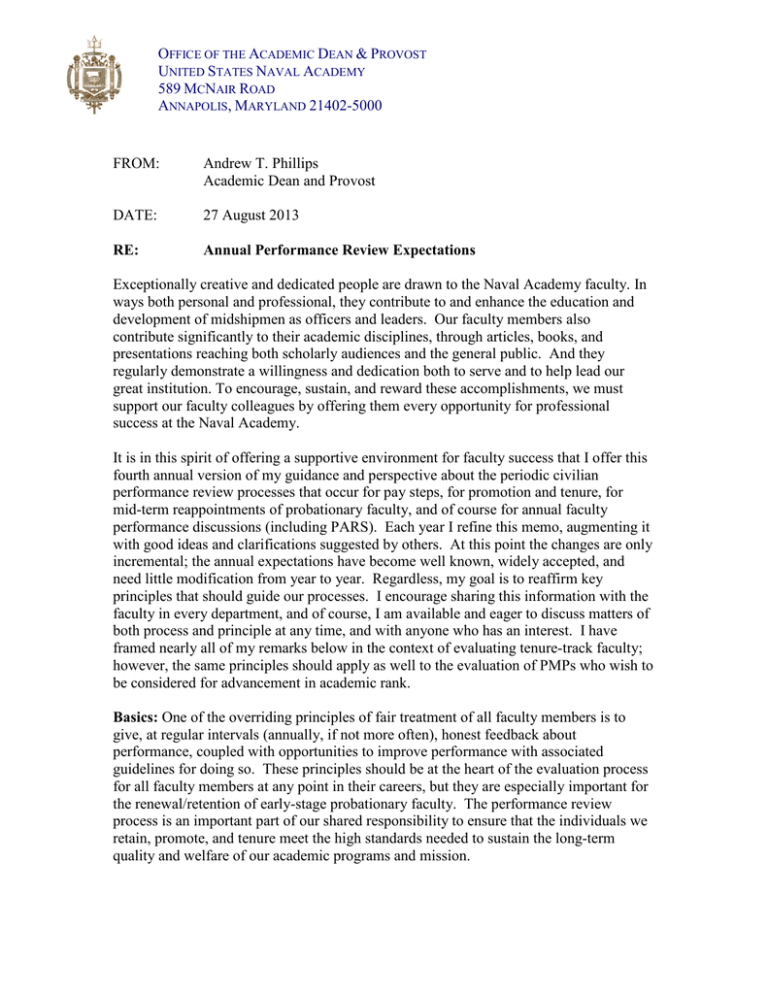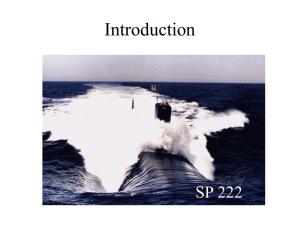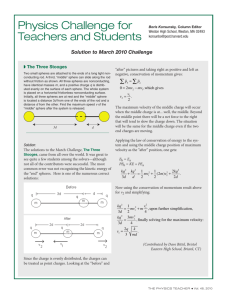Document 11064131
advertisement

OFFICE OF THE ACADEMIC DEAN & PROVOST UNITED STATES NAVAL ACADEMY 589 MCNAIR ROAD ANNAPOLIS, MARYLAND 21402-5000 FROM: Andrew T. Phillips Academic Dean and Provost DATE: 27 August 2013 RE: Annual Performance Review Expectations Exceptionally creative and dedicated people are drawn to the Naval Academy faculty. In ways both personal and professional, they contribute to and enhance the education and development of midshipmen as officers and leaders. Our faculty members also contribute significantly to their academic disciplines, through articles, books, and presentations reaching both scholarly audiences and the general public. And they regularly demonstrate a willingness and dedication both to serve and to help lead our great institution. To encourage, sustain, and reward these accomplishments, we must support our faculty colleagues by offering them every opportunity for professional success at the Naval Academy. It is in this spirit of offering a supportive environment for faculty success that I offer this fourth annual version of my guidance and perspective about the periodic civilian performance review processes that occur for pay steps, for promotion and tenure, for mid-term reappointments of probationary faculty, and of course for annual faculty performance discussions (including PARS). Each year I refine this memo, augmenting it with good ideas and clarifications suggested by others. At this point the changes are only incremental; the annual expectations have become well known, widely accepted, and need little modification from year to year. Regardless, my goal is to reaffirm key principles that should guide our processes. I encourage sharing this information with the faculty in every department, and of course, I am available and eager to discuss matters of both process and principle at any time, and with anyone who has an interest. I have framed nearly all of my remarks below in the context of evaluating tenure-track faculty; however, the same principles should apply as well to the evaluation of PMPs who wish to be considered for advancement in academic rank. Basics: One of the overriding principles of fair treatment of all faculty members is to give, at regular intervals (annually, if not more often), honest feedback about performance, coupled with opportunities to improve performance with associated guidelines for doing so. These principles should be at the heart of the evaluation process for all faculty members at any point in their careers, but they are especially important for the renewal/retention of early-stage probationary faculty. The performance review process is an important part of our shared responsibility to ensure that the individuals we retain, promote, and tenure meet the high standards needed to sustain the long-term quality and welfare of our academic programs and mission. These overall goals are best achieved when we provide evaluations and assessments that are comprehensive, frank, and honest. And while it is natural and appropriate for departmental colleagues, including the Chair, to consider their role in the performance review process as one of advocacy on behalf of a faculty member, this support must not be given at the expense of frankness and honesty. Concerns about faculty performance should be identified and explained in writing along with explicit remedies, rather than 1) ignoring them in hopes that they will disappear on their own (doesn’t often happen) or that someone else will deal with them (may happen, but is not a responsible approach), or 2) addressing them in “sidebar” conversations within the department but not passing them “up the chain of command.” These alternative approaches are harmful to individuals and to the institution, and are the things that lead to the occasional “surprise” decision that none of us wants. Furthermore, such approaches preclude the involvement of the Division Directors and Deans in addressing performance issues early. The above comments focus on addressing concerns about performance or contribution precisely because this is an uncomfortable part of the performance evaluation process and one in which it is easy to falter. But I want to be quick to add the obvious point that the performance evaluation process also should be used to showcase and acknowledge faculty achievement and excellence. The Academy is full of committed faculty who make extraordinary contributions to their profession and to the education of midshipmen. We should applaud those accomplishments as often as possible. Criteria: Excellence in teaching is a tradition among Naval Academy faculty and is expected of all faculty members. This expectation results directly from the unique Naval Academy mission; in this regard, Naval Academy standards are comparable to those of the nation’s finest institutions of higher education. Faculty members whose excellence as teachers and mentors has not been clearly demonstrated will not be promoted or tenured, and are unlikely to compete favorably for annual merit pay step increases. Demonstrated excellence in teaching is the most important of our performance criteria; no amount of research, scholarly, or extracurricular accomplishment can outweigh mediocre performance in the classroom. Outstanding teaching requires self-discipline, commitment, and effort. It requires a faculty member to create a challenging but supportive and engaging learning environment. Some examples (not an exhaustive list) of broad measures of effective teaching include the establishment of an environment that fosters student learning; demonstrated student learning and motivation to learn; modeling professionalism in behavior and interpersonal demeanor in the classroom; contributions of individual faculty members to the assessment of student learning, and the use of the results to improve student learning and the student experience; tangible course and laboratory development; regular peer and student evaluation of the course and instruction received; mentoring midshipmen in directed study and research courses; serving as a Trident Scholar or Honors advisor (which also represents research and scholarly activity in most cases); and serving as a Plebe advisor or as an academic advisor / mentor to midshipmen in a major or minor. This last element of “teaching” is often overlooked in our annual evaluations, and yet providing high quality, thoughtful, and individualized mentoring and academic advising is an ongoing expectation we have of all faculty members. As always, USNAINST 12550.4B remains an important source of specific guidance on the importance of effective teaching and on the ways in which Chairs and department colleagues are expected to provide their assessment of that effectiveness. Excellence in research and/or scholarship appropriate to the discipline, like excellence in classroom teaching, is a continuing expectation for all faculty members throughout a career at the Naval Academy. Tangible evidence of research / scholarly excellence, especially evidence involving a rigorous and substantive peer-validated review process, provides the strongest single indicator of a person’s currency in his or her academic discipline, as well as exemplifying that person’s ability to foster a thirst for life-long learning among the midshipmen. Some examples (again, not an exhaustive list) are peerevaluated publications and presentations; authorship of books or book chapters; invitations to participate in or lead conference panels and workshops; and the acquisition of external research grant support. Of course, some of these forms of evidence are expected of faculty members (e.g., peer-evaluated scholarly works) while others are not (e.g., external research grants). In addition, the determination of which forms of scholarship and research are “appropriate to the discipline” and which are of highest value / priority at the Naval Academy (e.g., is a book of greater or lesser value than a journal article in discipline X?) must be clearly understood between all those involved in the evaluation process: the faculty candidate, the department, the division, and those at the institutional level (the P&T committee or the Dean’s office, depending on the circumstances). It is natural that there will be differences in this value system from one discipline to the next, but the expectations within each discipline must be agreed upon and well understood at every level, and they must persist over time. Ultimately, it is the responsibility of the Department Chair of each department to ensure that this shared understanding is in place and is clearly communicated to everyone involved. Excellence in service is the third of the three areas of expected faculty responsibility at the Naval Academy. The civilian professoriate embodies the academic excellence, continuity, and institutional memory of the Naval Academy, and demonstrated contributions in service to the Naval Academy are a primary means for determining a candidate’s comprehensive understanding of and commitment to the Naval Academy mission. Without the outstanding service that career faculty members provide to the institution, and to its wide range of curricular and extracurricular activities, accomplishing the Naval Academy mission would be impossible. Some examples of service contributions include participating in significant curriculum development activities; facilitating and leading extracurricular language and cultural immersion activities; serving on the Faculty Senate; contributing to department, division, or institutional assessment activities; participating as a faculty representative for a major extracurricular activity or club or varsity sport; and substantive committee service at every level of the Naval Academy. It may also include professional service such as conference planning, work on behalf of professional organizations, or reviewing books and journal articles. Again, this is not a comprehensive list. Additionally, evaluation of faculty service contributions considers a candidate’s demonstrated ability to work effectively with others in advancing the Academy mission beyond the contributions normally associated with classroom teaching and scholarly work. That is, collegiality, civility, and constructive and productive departmental and institutional citizenship are essential elements of faculty service. Building the case: Each faculty member has primary responsibility for providing sufficient evidence and information to build a case for his or her favorable review. With advice and mentoring from departmental colleagues and the Chair, the faculty member should be encouraged to develop, organize, and submit materials that document strengths and achievements in each area of the three areas of faculty responsibility. The documentation need not be exhaustive, but should be thoughtfully and carefully selected to document, illuminate, or support particular assertions about strengths in performance. And, of course, Chairs and departmental colleagues may introduce additional evidence beyond that submitted by the faculty member, but the source should be clearly identified. The essential roles of the Chair and of departmental colleagues (when appropriate) are to analyze, evaluate, and assess – honestly and professionally – the evidence or data (quantitative and/or qualitative) and to reach specific conclusions about that person’s performance in each major area of faculty responsibility. It is important to be able to track assessments of performance back to identifiable elements in the supporting materials; assertions about performance (whether negative or glowingly positive) for which no evidence is provided generally lead to skepticism. In short, there must be evidence (and better yet, a pattern of evidence) to confirm all assertions made regarding performance. In conducting the evaluation and assessment of performance, mere “executive summaries” of the documentation provided fall short of what is expected. Evaluators (i.e., Chairs and departmental colleagues) should apply judgment to reach conclusions about the extent and quality of an individual’s performance in each major area (teaching, research / scholarship, and service) as well as overall performance, linking that judgment to the evidence provided. It is helpful if evaluators reach – and state explicitly – a conclusion of whether a faculty member’s performance meets expectations in each area. For example, a performance report might state that Assistant Professor X taught an array of courses, updated this course in a certain way, and received such and such evaluations on his or her student opinion forms. That may be a useful summary, but it does not make clear whether the department regards that level of performance as meeting (or not) our high Naval Academy expectations. It is also helpful if evaluators provide an appropriate disciplinary context to aid in understanding the relevance of particular achievements and how and why they view them as they do. Examples are: a certain journal is regarded as the highest-impact in the field; speaking or presenting a paper at a particular conference is especially prestigious; this funding agency is particularly competitive on a national scale; work in this particular scholarly area is especially challenging because…; publication rates in this sub-discipline tend to be low because…; this level of achievement in this course is particularly noteworthy because…; and so on. This extra effort will enrich and strengthen the case being made, will help clarify whether a particular contribution is truly exceptional (or merely ordinary), and will reduce the chances of anyone’s misinterpreting a particular achievement. Promotion and Tenure. Recommendations for promotion and tenure are among the most momentous outcomes of the performance evaluation process. These decisions have serious, long-term, cumulative effects on the caliber of our faculty and the academic welfare of the Naval Academy and – obviously – impact the career paths of individual faculty. As noted above, honesty and forthrightness in previous annual evaluations of performance set the stage for work during the decision year that is fair to the individual candidate and that safeguards the institution. Expectations for tenure and advancement to the rank of Associate Professor require demonstrated and sustained performance as an outstanding and effective teacher, evidence of a sustained pattern of high quality research / scholarship, and a modest but sufficient level of contribution in service to the Academy. And these accomplishments must be demonstrated during the period of employment at the Naval Academy and under the normal conditions / circumstances experienced by Naval Academy faculty members (i.e. a “full-time” teaching load, no teaching assistants, etc.). Because of the overriding importance of the teaching and research / scholarly components for faculty early in their Naval Academy career, candidates seeking tenure and advancement in rank to Associate Professor may need to exercise some restraint regarding overly time-consuming service commitments. Nevertheless, there must be evidence of sufficient service contributions demonstrating a person’s comprehensive understanding of and commitment to the Naval Academy mission and the ability to work effectively and collegially with others in advancing that mission. While promotion to Associate Professor and the awarding of tenure are closely linked at the Naval Academy, promotion in rank is basically “backward looking,” in recognizing what a faculty member has accomplished during prior years, while an award of tenure is basically “forward looking,” in predicting future activities and accomplishments. An award of tenure carries a promise of career-long contributions of increasing value to the Naval Academy and one’s discipline. Of course, we base that forward-looking assessment on the existing “trajectory” and record of sustained accomplishments that the faculty member has established during all prior years of service at the Naval Academy. Expectations for advancement to the rank of Professor include demonstrated and sustained accomplishment as a master teacher, continuing evidence of a sustained pattern of high quality research / scholarship, and significant contributions in service to the Academy. The rank of Professor embodies the highest ideals and standards of the Naval Academy professoriate. Faculty members seeking promotion to the rank of Professor are expected to exhibit the qualities of a master teacher in such tasks as mentoring junior faculty, directing the demanding challenges of multi-section courses, and helping to lead the continuous improvement of departmental and Naval Academy academic programs. Candidates for the rank of Professor – and faculty serving in that rank – are expected to provide clear evidence of their commitment and ability to further the Academy’s mission beyond the classroom. In short, faculty promoted to this rank should be obvious models of academic and institutional excellence to midshipmen and colleagues, both military and civilian and both junior and senior in rank. Early Tenure and Promotion to Associate Professor: One requirement for promotion and tenure is that a faculty member must have completed a minimum of five years of college-level teaching experience following receipt of the terminal degree (Ph.D. or equivalent). Hence, probationary faculty members normally are reviewed for the purpose of granting tenure and promotion to Associate Professor during either the fifth or sixth full year of service at the Academy; that is, the consideration for promotion and tenure occurs following four or five full-time years at the rank of Assistant Professor at the Naval Academy. However, some probationary faculty members have several years of college level teaching experience prior to coming to the Academy (and following receipt of the terminal degree). Review of faculty members who are beyond the five year minimum teaching experience eligibility criterion, but who are not yet serving in their fifth full year of service at the Academy, is considered an early promotion and tenure review. The granting of tenure and the awarding of promotion at this earlier stage is an exceptional and rare action that recognizes truly unusual and extraordinary achievement in all areas of faculty responsibility, along with a complete absence of any concerns about performance. Merit Pay Steps: The Naval Academy civilian faculty merit pay system is based on an annual review of faculty performance. Merit pay steps are awarded for excellent performance and meritorious accomplishments using the same criteria as described above for promotion and tenure. Faculty recommended for annual merit pay increases should have significant, demonstrable accomplishments on behalf of midshipmen, the Naval Academy, and the discipline they represent. As always, demonstrated effectiveness in teaching is primary; accomplishments in research / scholarship and service to the Naval Academy are also important and expected. The civilian faculty merit pay system does not provide for automatic pay increases; the merit pay system is based on the assessment of meritorious performance by the cognizant chain of command and does not include “longevity raises.” Year in and year out, our faculty members achieve impressive results in their classrooms, in their research and scholarship, and in their service to the institution. It is incumbent upon us to recognize those accomplishments and to enable their efforts for even more. Our collective goal should be to support our faculty in these endeavors, and we should offer them every opportunity to do so successfully. I hope the thoughts I have shared here will support that outcome.





